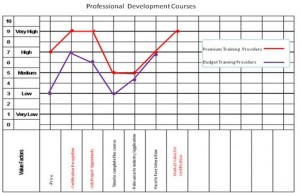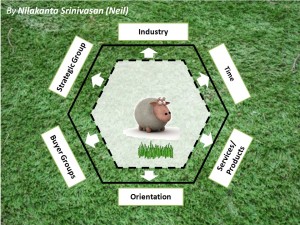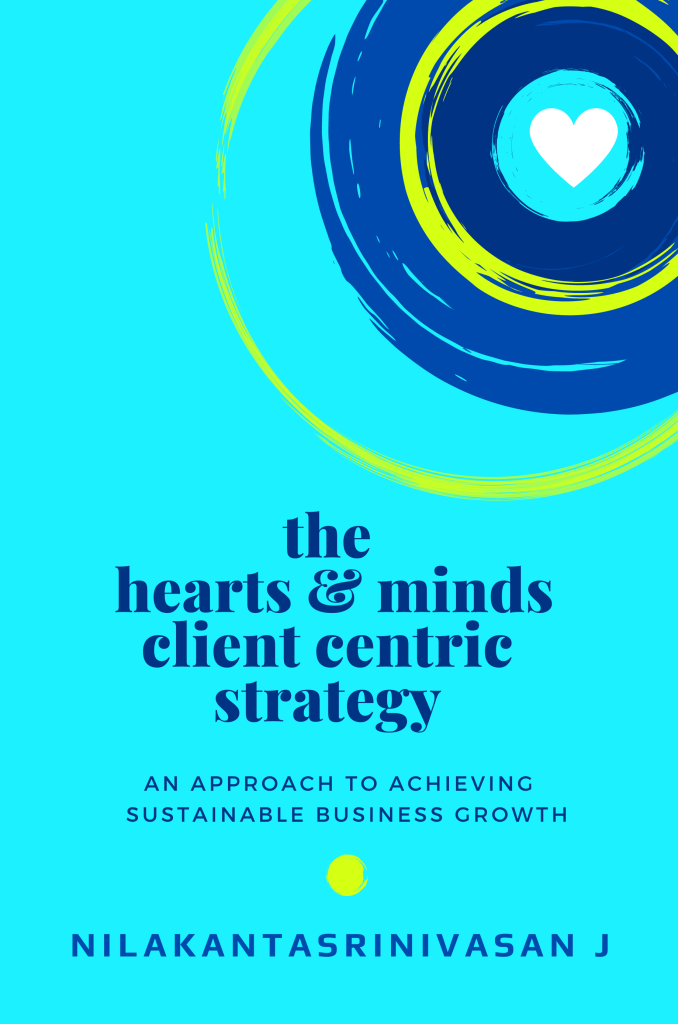Blue Ocean strategy shapes strategic structure to create new demand and generate high growth for the company. To create such a strategy, there are a set of analytical tools and frameworks used in formulating and executing it. The first and foremost tool in value innovation and creation of blue ocean strategy is the strategy canvas.
Also known as Snake Plot, the basic component of strategy canvas is value curve that is nothing but a graphical form of company & competition’s current state of play in the known market. This mapping makes us understand where the competition is currently focusing, the factors that the industry competes in selling its products, service and delivery and what the customers receive from the existing competitive offering on the market. Strategy canvas helps us to reconstruct the buyer value essentials by questioning its existing industry’s strategy and business model by shifting our focus from competitors to alternatives and from customers to non-customers of the industry thus making a trade-off between value and cost. It tells the story in one page.
How to read a value curve of strategy canvas?
The horizontal axis captures the key factors the industry competes on and invests in. The vertical axis of the strategy canvas is a rating scale that captures the current state of play of key competing factors
How strategy canvas is created?
Key factors are those value creating components a company invests in resources, processes and capabilities and involves strategic choices and impacts strategic purpose. To know the key elements the team has to do extensive research and analysis within the organization as well as outside, interactions with customers about the product, service and delivery. After determining the key elements, the team has to give rating to these elements. The rating given may be relatively low, low, medium, high, relatively high etc. The rating given to each key factor must be fair and unbiased. Let us consider an example from the professional development and education sector.

The above graphical depiction shows the professional development courses offered by the premium training providers and budget training providers. The horizontal axis has the key factor such as price, certification recognition, job/project opportunity, time to complete this course, relevance to industry/application, face to face interaction and market value for certification. The vertical axis shows the relative value buyers receive across all these key competing factors. For example, premium providers price their product/service higher than budget providers and so on.
Thus by preparing the strategic canvas the company is ready to explore how to redraw its strategy to create blue ocean. It forms the basis of value creation and value capture for a company and helps in creating value innovation.
The strategic canvas can be constructed for different strategic groups (organizations that differentiate themselves by pricing) or between the organization and its competitors.
The primary difference is in the application of strategic canvas after its creation. In case of Blue Ocean Strategy, the next step is to include substitutes and alternatives in the canvas rather than mean competitors within the industry. After inclusion, the team uses the 4 action framework to create Blue Oceans.
To break from competition, a organization has to reconstruct the market boundary which is the first and foremost principle in creating blue ocean strategy. There are six basic approaches to reconstruct market boundaries, also known as Six Paths Framework. These paths challenge the conventional approach of the organization in strategy formulation to work within its boundaries, but instead break out of the known boundaries. This helps them to move out of red oceans and create blue oceans.
The six paths framework in formulating blue ocean strategy are (1) Look across alternative industries, (2) Look across strategic groups within industry, (3)Look across buyer groups, (4) Look across complementary product and service offerings, (5)Look across the functional-emotional orientation of an industry and (5)Look across time to shape trends.

6 paths framework blue ocean strategy
Following are the six paths framework involved in formulating the blue ocean strategy.
Path 1: Look across alternative industries
Organizations compete not only within the industries but also with organizations in other industries which produce alternative product and services to their industry.
One of the biggest limitations we put on our organization is to assume that our products/services compete in a defined and unchanging industry with a very narrow view of the environment.
The first path in formulating the blue ocean strategy is to find the alternative industries to your industry’
In order to understand this path let us first understand difference between substitute and alternative:
- Substitutes are products or services that have different forms but offer the same functionality or core utility.
- Alternatives are products or services that have different functions and forms but the same purpose.
Let us consider an example from entertainment industry. The function of this industry is to provide entertainment and the purpose of this industry is relax, rewind, de-stress, experience and fun. The substitutes to this industry are CDs, TV, stage shows, etc. But the alternatives to this industry include visiting a mall, library, hobby centre, etc., all of which serves the same purpose.
Thus by focusing on the key factors that lead buyers to trade across alternative industries and by eliminating or reducing everything else, you can create a blue ocean of new market space.
Let us take the case of pro-biotic drink Yakult. It competes with health drinks, juice brands, at the same time it competes with pharma industry. However, both health drinks producers & pharma brands don’t consider Yakult as their competition. Thus Yakult has created a blue ocean for itself across industries.
Path 2: Look across strategic groups
Strategic groups within Industries are group of organizations within an industry that pursue a similar strategy. Strategic groups include a hierarchical order built on two dimensions, price and performance. Thus by looking across strategic groups, an organization has to find why do buyers trade up for the higher group, and why do they trade down for the lower one?
TATA chose not to compete with entry level strategic group of cars in India such as Maruti Omni, Maruti 800, Alto & Hyundai Santro. Instead it questioned the un-questioned notion that cars can’t be less than a lakh of Indian Rupees. It looked for factors which, Maruti 800 buyers would trade down or 2 wheeler buyers would trade up!
Path 3: Look across Buyer Groups
In most industries, competitors converge around a common definition of target buyer. However there are chain of buyers who are directly or indirectly involved in buying decisions, such as:
- Purchasers who pay for the product or service
- Actual users who use the products
- Influencers who have a role to play in decisions
- Intermediate buyers who are traders
- Regulators who influence the buying decisions
Thus blue ocean strategy is formulated by finding out who are the chain of buyers in your industry and which buyer group does your industry typically focus on? And if you shift the focus from one buyer group to another, how can you unlock new value?
Novodisk, a leading producer of insulin created blue ocean by focusing on diabetes patients instead of doctors & nurses who are traditionally targeted. Thus they created travel friendly, easy to use, hassle free, easy to set, fancy looking, pen like shots instead of syringes and insulin bottles.
Path 4: Look across complementary product and service offerings
An organization has to think about what happens before, during, and after your product/service is used by the consumers. In most industries, competitors converge within the boundary of their industry’s product and service offerings. By understanding the context in which your product or service is used and what happens before, during, and after, you can identify pain points (constraints) of the consumers, eliminate these pain points through a complementary product or service offering.
Philips saw that the biggest issue in brewing tea was not in the kettle itself but in the complementary product of water, which had to be boiled in the kettle. The issue was the lime scale found in tap water. Philips saw this as an opportunity and solved the major pain point of customer that related to water rather than their kettle by adding a mouth filter in the kettle that effectively captured the lime scale as the water was poured.
Path 5: Look across the functional-emotional orientation of an industry
Emotional Appeal to buyers refers to the emotional utility a buyer receives in the consumption or use of a product or service. Competition tends to converge on one of two possible basis of appeal. ‘What are the extras we offer that add to the cost of our product without enhancing functionality? By eliminating or reducing these factors, can we create a simpler, functional, lower-priced, lower-cost offering that would dramatically raise buyers’ value’. These are to be questioned in blue ocean strategic formulation.
Functional Appeal to buyers refers to the functional utility buyers receive from a business or product/service based on basic calculations of utility and price. Competition in an industry tends to converge on one of two possible basis of appeal. What emotional elements can we raise or create to infuse our commodity products with new life by adding a dose of emotion?
By understanding your industry focus on functionality or emotional appeal, you can either compete on emotional appeal by stripping functional elements or compete on functionality by adding emotional elements.
Fast Food producer, Subway uses emotional appeal to trade up its range of products which usually have more functional appeal rather than emotional. Fast food industry is driven by price and waiting time which are functional. This industry rarely competes on emotional appeal.
Path 6: Look across time
Many of us respond to trends in our industry at the point they are making an impact. In other words we create reactive strategies, which allow us to adapt to a changing environment. All industries are subject to external trends that affect their business over time. Instead of adapting incrementally and somewhat passively, one can gain insights into how the trend(s) will change value to customers and impact their organization’s business model.
To assess trends across time, three criteria are critical: the trend must be decisive to the business, irreversible and have a clear trajectory. By knowing what trends have a high probability of impacting your industry, are irreversible, and evolving in a clear trajectory, you can open up unprecedented customer utility.
Free Download
Get your copy of E-Book “The Hearts & Minds Client Centric Strategy” on how to achieve sustainable business growth . It contains cases, examples, detailed implementation approach along with ideas to achieve sustainable growth, especially for B2B firms. (Pages : 51)
When we look across these six paths at the commencement of our strategy formulation we find that this process helps us create new perspectives. Our thinking becomes more creative.
It seems simple, because it is. However, it’s when we actually start the process of looking across these six paths we find our assumptions start to break down and simultaneously we awaken to new perspectives about our organization and its industry. And it’s from this place that innovations and new opportunities are created.
Sign-up for collaborat newsletter

